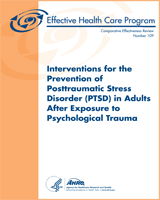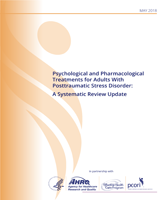NCBI Bookshelf. A service of the National Library of Medicine, National Institutes of Health.
Gartlehner G, Forneris CA, Brownley KA, et al. Interventions for the Prevention of Posttraumatic Stress Disorder (PTSD) in Adults After Exposure to Psychological Trauma [Internet]. Rockville (MD): Agency for Healthcare Research and Quality (US); 2013 Apr. (Comparative Effectiveness Reviews, No. 109.)
This publication is provided for historical reference only and the information may be out of date.

Interventions for the Prevention of Posttraumatic Stress Disorder (PTSD) in Adults After Exposure to Psychological Trauma [Internet].
Show detailsKEY QUESTION 1
Cognitive Behavioral Therapy (CBT)
Sensitivity Analyses: Including the high risk of bias study Bryant, 1999

Figure H1
Mean change from baseline to end of treatment in PTSD incidence rates for CBT compared with supportive counseling.

Figure H2
Mean change from baseline to 6-month followup in PTSD incidence rates for CBT compared with supportive counseling.

Figure H3
Mean change from baseline to end of treatment in IES Avoidance Subscale symptom scores for CBT compared with supportive counseling.

Figure H4
Mean change from baseline to 6-month follow-up in IES Avoidance Subscale symptom scores for CBT compared with supportive counseling.

Figure H5
Mean change from baseline to end of treatment in IES Intrusion Subscale symptom scores for CBT compared with supportive counseling.

Figure H6
Mean change from baseline to 6-month follow-up in IES Intrusion Subscale symptom scores for CBT compared with supportive counseling.

Figure H7
Mean change from baseline to end of treatment in anxiety symptom scores for CBT compared with supportive counseling.

Figure H8
Mean change from baseline to 6-month follow-up in anxiety symptom scores for CBT compared with supportive counseling.

Figure H9
Mean change from baseline to end of treatment in depression symptom scores for CBT compared with supportive counseling.

Figure H10
Mean change from baseline to 6-month follow-up in depression symptom scores for CBT compared with supportive counseling.
- Sensitivity Analyses - Interventions for the Prevention of Posttraumatic Stress ...Sensitivity Analyses - Interventions for the Prevention of Posttraumatic Stress Disorder (PTSD) in Adults After Exposure to Psychological Trauma
- Screening and Quality Assessment Forms - Management of Postpartum HemorrhageScreening and Quality Assessment Forms - Management of Postpartum Hemorrhage
- Antipsychotics for Mania - Treatment for Bipolar Disorder in Adults: A Systemati...Antipsychotics for Mania - Treatment for Bipolar Disorder in Adults: A Systematic Review
- Systematic Treatment Enhancement Program for Bipolar Disorder (STEP-BD) Study an...Systematic Treatment Enhancement Program for Bipolar Disorder (STEP-BD) Study and Other Psychosocial and Somatic Interventions - Treatment for Bipolar Disorder in Adults: A Systematic Review
- Evidence Tables - Social and Structural Determinants of Maternal Morbidity and M...Evidence Tables - Social and Structural Determinants of Maternal Morbidity and Mortality: An Evidence Map
Your browsing activity is empty.
Activity recording is turned off.
See more...
